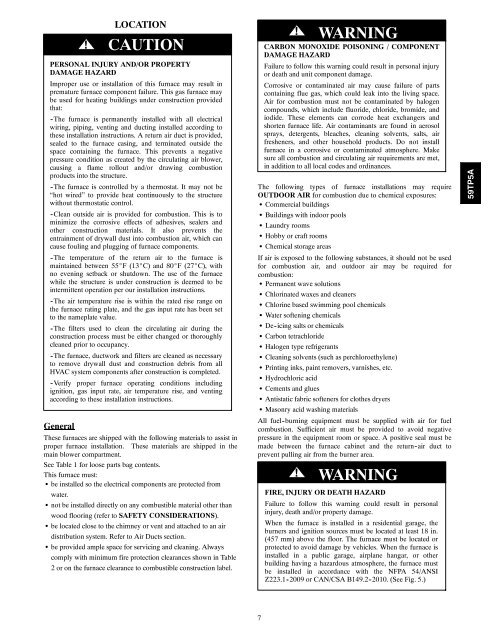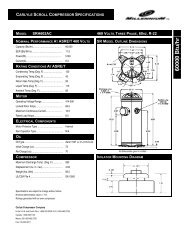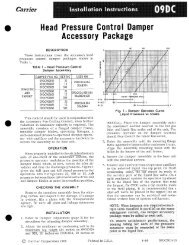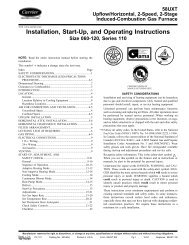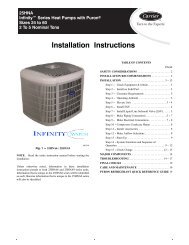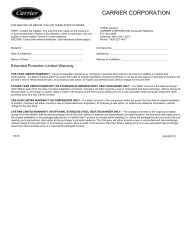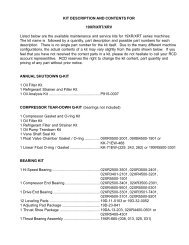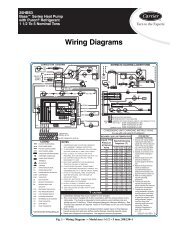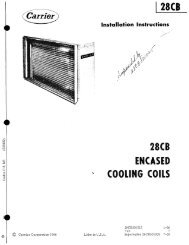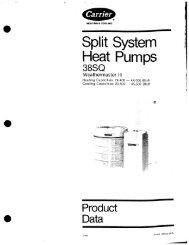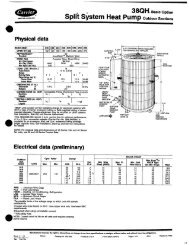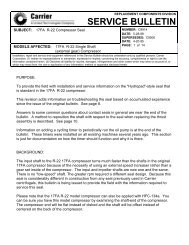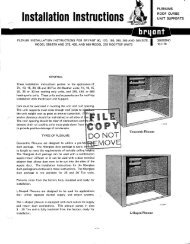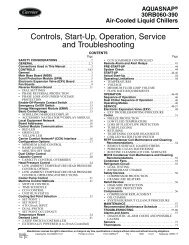warning - Docs.hvacpartners.com
warning - Docs.hvacpartners.com
warning - Docs.hvacpartners.com
You also want an ePaper? Increase the reach of your titles
YUMPU automatically turns print PDFs into web optimized ePapers that Google loves.
!LOCATIONCAUTIONPERSONAL INJURY AND/OR PROPERTYDAMAGE HAZARDImproper use or installation of this furnace may result inpremature furnace <strong>com</strong>ponent failure. This gas furnace maybe used for heating buildings under construction providedthat:-The furnace is permanently installed with all electricalwiring, piping, venting and ducting installed according tothese installation instructions. A return air duct is provided,sealed to the furnace casing, and terminated outside thespace containing the furnace. This prevents a negativepressure condition as created by the circulating air blower,causing a flame rollout and/or drawing <strong>com</strong>bustionproducts into the structure.-The furnace is controlled by a thermostat. It may not be“hot wired” to provide heat continuously to the structurewithout thermostatic control.-Clean outside air is provided for <strong>com</strong>bustion. This is tominimize the corrosive effects of adhesives, sealers andother construction materials. It also prevents theentrainment of drywall dust into <strong>com</strong>bustion air, which cancause fouling and plugging of furnace <strong>com</strong>ponents.-The temperature of the return air to the furnace ismaintained between 55_F (13_C) and 80_F (27_C), withno evening setback or shutdown. The use of the furnacewhile the structure is under construction is deemed to beintermittent operation per our installation instructions.-The air temperature rise is within the rated rise range onthe furnace rating plate, and the gas input rate has been setto the nameplate value.-The filters used to clean the circulating air during theconstruction process must be either changed or thoroughlycleaned prior to occupancy.-The furnace, ductwork and filters are cleaned as necessaryto remove drywall dust and construction debris from allHVAC system <strong>com</strong>ponents after construction is <strong>com</strong>pleted.-Verify proper furnace operating conditions includingignition, gas input rate, air temperature rise, and ventingaccording to these installation instructions.GeneralThese furnaces are shipped with the following materials to assist inproper furnace installation. These materials are shipped in themain blower <strong>com</strong>partment.See Table 1 for loose parts bag contents.This furnace must:S be installed so the electrical <strong>com</strong>ponents are protected fromwater.S not be installed directly on any <strong>com</strong>bustible material other thanwood flooring (refer to SAFETY CONSIDERATIONS).S be located close to the chimney or vent and attached to an airdistribution system. Refer to Air Ducts section.S be provided ample space for servicing and cleaning. Always<strong>com</strong>ply with minimum fire protection clearances shown in Table2 or on the furnace clearance to <strong>com</strong>bustible construction label.! WARNINGCARBON MONOXIDE POISONING / COMPONENTDAMAGE HAZARDFailure to follow this <strong>warning</strong> could result in personal injuryor death and unit <strong>com</strong>ponent damage.Corrosive or contaminated air may cause failure of partscontaining flue gas, which could leak into the living space.Air for <strong>com</strong>bustion must not be contaminated by halogen<strong>com</strong>pounds, which include fluoride, chloride, bromide, andiodide. These elements can corrode heat exchangers andshorten furnace life. Air contaminants are found in aerosolsprays, detergents, bleaches, cleaning solvents, salts, airfresheners, and other household products. Do not installfurnace in a corrosive or contaminated atmosphere. Makesure all <strong>com</strong>bustion and circulating air requirements are met,in addition to all local codes and ordinances.The following types of furnace installations may requireOUTDOOR AIR for <strong>com</strong>bustion due to chemical exposures:S Commercial buildingsS Buildings with indoor poolsS Laundry roomsS Hobby or craft roomsS Chemical storage areasIf air is exposed to the following substances, it should not be usedfor <strong>com</strong>bustion air, and outdoor air may be required for<strong>com</strong>bustion:S Permanent wave solutionsS Chlorinated waxes and cleanersS Chlorine based swimming pool chemicalsS Water softening chemicalsS De -icing salts or chemicalsS Carbon tetrachlorideS Halogen type refrigerantsS Cleaning solvents (such as perchloroethylene)S Printing inks, paint removers, varnishes, etc.S Hydrochloric acidS Cements and gluesS Antistatic fabric softeners for clothes dryersS Masonry acid washing materialsAll fuel-burning equipment must be supplied with air for fuel<strong>com</strong>bustion. Sufficient air must be provided to avoid negativepressure in the equipment room or space. A positive seal must bemade between the furnace cabinet and the return -air duct toprevent pulling air from the burner area.! WARNINGFIRE, INJURY OR DEATH HAZARDFailure to follow this <strong>warning</strong> could result in personalinjury, death and/or property damage.When the furnace is installed in a residential garage, theburners and ignition sources must be located at least 18 in.(457 mm) above the floor. The furnace must be located orprotected to avoid damage by vehicles. When the furnace isinstalled in a public garage, airplane hangar, or otherbuilding having a hazardous atmosphere, the furnace mustbe installed in accordance with the NFPA 54/ANSIZ223.1 -2009 or CAN/CSA B149.2 -2010. (See Fig. 5.)59TP5A7


